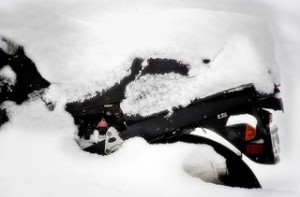10 Tips for Winterizing your Motorcycle
Winter can be a long season – it seems to arrive so quickly and last too long for some of us. Properly winterizing your motorcycle, then taking a few minutes each month to check them, will save time and money in the spring and get us on the road safely that much quicker.
 In all cases, check your owner’s manual for the manufacturer’s recommendations for proper winter storage. If you don’t have one, get one – they’re invaluable. You’ll be amazed at what you can do yourself.
In all cases, check your owner’s manual for the manufacturer’s recommendations for proper winter storage. If you don’t have one, get one – they’re invaluable. You’ll be amazed at what you can do yourself.
Most of these steps should already be done. However, if winter snuck up on you, like it usually does for me (waiting for one last ride), you may still need to tend to some of these details. It’s never too late.
Tips for Winterizing your Motorcycle
- Read your owner’s manual.
- Clean your motorcycle. Bugs can be corrosive. Wash it well, wax it, polish chrome, make sure it’s dry before storing.
- Lubricate bolts, cables – any parts that are prone to rust. Clean your chain (if you have one) well and make sure it’s well lubricated. Kerosene makes an excellent cleaner.
- Put your bike on its center stand. If it doesn’t have one, consider using a lift or even carefully propping up the bike using blocks. This takes the pressure off the suspension and tires.
- Elevate both tires off the ground. If you’re unable to do this, the next best thing is to move your bike around every couple of weeks so tires aren’t sitting on the same spot for extended periods and developing flat spots. Inflate your tires to the maximum recommended pressure to maintain their shape – tires tend to lose air pressure when it’s cold.
- Keep your battery charged. Caring for it will save needless grief – and cost — in the spring. Clean your battery leads and attach a battery tender to keep it fully charged. Another option is to remove the battery and place it on a charger.
- Block air intake and exhaust pipes with plastic bags, steel wool, duct tape – anything to keep the critters out. I know this from personal experience when one spring I discovered my air filter was full of sunflower seeds.
- Fill your gas tank completely to prevent condensation and add a manufacturer recommended fuel stabilizer. If your bike is carbureted, your owners manual will likely advise you to drain the carbs – you can do this by running the engine with the fuel tap in the “off” position until you effectively run out of gas.
- Change your engine oil and oil filter. While less of a problem than it used to be, oil can have contaminants in it that can damage your engine if left for extended periods. Besides, if it’s done in the winter, you ready to go in spring! Read: 21 Simple Steps to Change Your Oil
- Cover it to protect from dust. Watch to make sure that there is no condensation.
